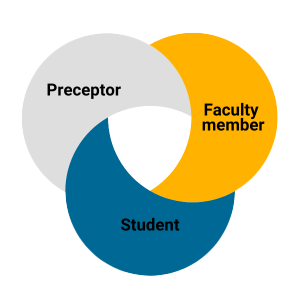Overview
Empowering preceptors for success
The relationship between the student learner and their preceptor offers unique learning opportunities that support the transition from a novice to competent team member. As a preceptor, you play a critical role in shaping the future of health care and patient outcomes by guiding students in evidence-based decision-making, professional development and hand-on patient care.
Teaching-Learning Triad

The teaching-learning relationship involves a triad of the student, preceptor and clinical faculty member. Each person in the triad has responsibilities in the teaching and learning process:
- Student: Responsible for active learning, applying knowledge in practice and seeking feedback
- Preceptor: Guides, mentors and assesses the student’s clinical growth
- Faculty Member: Provides oversight, resources and support to both student and preceptor
This triad ensures a dynamic and structured learning environment where all members are committed to the student’s success.
Visit Clinical Practicum Roles and Responsibilities or Leadership Practicum Roles and Responsibilities for more detailed information about the roles of preceptors vs. students vs. faculty.
From Start to Finish
Essential steps before and during the practicum
The following are the key stages of the practicum. Each phase is designed to support both the preceptor and the student in making the most of the experience and fostering the student’s professional growth.
- Before the Practicum Begins: Get Set Up for Success
Start the journey by completing all onboarding tasks, reviewing learning objectives and ensuring students have the necessary access to tools and resources. This step lays the foundation for a smooth, productive clinical experience.
- Getting Started: Kick Off the Experience
Begin by setting clear expectations with your student, orienting them to the clinical environment and identifying key learning opportunities. This initial phase ensures your student feels welcomed and prepared to engage in meaningful learning. See Clinical Practicum Initial Meeting or Leadership Practicum Initial Meeting for more details.
- Midpoint Check-In: Assess Progress and Address Challenges
At the midpoint of the practicum, assess the student’s progress, offer constructive feedback and discuss any challenges that may have arisen. This is also the time to reach out for faculty support, if needed, to ensure both you and your student remain on track.
- Evaluation and Reflection: Conclude the Experience
Wrap up the practicum by conducting a formal evaluation of the student's performance, gathering feedback from them on their experience and completing a preceptor survey. This final step enhances the learning experience for both you and the student, while providing valuable insight for future improvement. See Clinical Practicum Feedback and Evaluation or Leadership Practicum Feedback and Evaluation for more details.